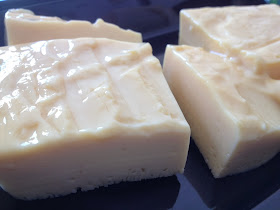Deco Rolls
I'm not sure how I first came across deco rolls, or patterned swiss rolls, but I was immediately impressed. The beautiful designs looked perfect, almost machine-printed, and I couldn't work out how anyone could have made them at home. Using a technique that seems to have been pioneered by the Japanese, it looks so simple once you learn about it that you wonder why you never came up with the idea yourself.
 |
| Amazing deco rolls from http://www.pinterest.com/rosafdez/deco-roll-cakes/ |
Next, I tried using a separate (thicker) mixture for the decorations, using the recipe from La Recetas de la Felicidad. This resulted in well-defined lines, and my sponge was fluffy (almost too fluffy), but the problem was that the decorations had a different texture from the sponge, which looked not quite right. Also, I tried to roll the cake up too soon. It steamed up within the baking paper and left a wet layer on the surface.
 |
| Freehand design using thicker batter. |
 |
| Decorations had a different texture from the sponge. |
 |
| Deco roll covered in ganache and served as a chocolate log. |
To counteract all the cakes and cookies I was baking, I decided to make something savoury as well. I chose the advent bread wreath recipe from Alice and the Mock Turtle, but instead of filling it with ham and cheese, I used the tomatoes and onion I had on hand. I was tempted to make it red (with tomatoes) on one side and green (with herbs from the garden) on the other, but as I chopped too much tomato, I used it for filling the whole thing.
 |
| Plaiting the bread dough over the filling. |
 |
| Bread wreath after baking. |
You've probably made gingerbread cookies since you were children. My parents were not bakers, so I didn't get around to this till later, and this was the first time I had tried to string them together for hanging on the tree as well.
 |
| Gingerbread tree decorations. |
You can purchase cookie cutters specifically designed for making cookies that hook onto the edge of your cup, such as the hookie cookie cutters from Hoobbe, Wilton's Xmas-themed milk and cookies cookie cutters, or the Over the Edge cookie cutters. But really, it's not that hard to cut your own cookies. Some of your existing cookie cutters will probably already do the trick, for instance if you have a candy cane one. Or you could simply add a slot into a shape afterwards, or make minor tweaks like bending your gingerbread man's arm.
 |
| Over the Edge cookie cutters with a slot for your mug. |
 |
| My hanging gingerbread cookies. |
Believe it or not, I've been collecting those Air New Zealand lollies for years, for making stained glass cookies. Rather than crushing the candy though, I just put whole chunks in to bake. For a while it did not look like it would work, but finally, the sweets melted (apart from the one in the tree at the top of the picture below). I thought these looked great, but I would probably prefer to just eat gingerbread on its own.
 |
| Stained glass cookies. |
You may have seen the stacks of gingerbread stars that people form into trees. As I did not have lots of star cutters in different sizes, I went for making a stack of circles into a bell instead. I didn't have lots of circle cutters either, but I did have a bunch of cans, measuring cups and measuring spoons in various sizes.
 |
| Cutting shapes for making a 3D gingerbread bell. |
 |
| 3D gingerbread bell hanging on the tree. |
You'd think making cookies that slot together into 3D shapes would be really easy, once you had designed them in cardboard and checked that all the slots are in the right places. It turns out it is easier said than done, because the cookies will rise a little while baking. Make a slot too narrow, and you won't be able to slide another biscuit between it; you run the risk of breaking your cookie if you try to cut it wider after baking. Make a slot too wide, and the shapes don't fit in snugly, so your final product does not sit straight, unless you glue it together using royal icing, holding it in the right place until it sets.
If you don't have cookie cutters like the cuties from Suck UK, it can take forever to trace around all your cardboard shapes with a sharp knife as well. So you can imagine my sense of achievement when I finished making the reindeer and sleigh gingerbread shapes below. It took me several days to construct and decorate the pieces, and I lost several reindeer through carelessness (I started off with six of them), but I was pretty pleased when I got to the end.
Hope you had a great Christmas, and Happy New Year!
This post is part of Our Growing Edge, a monthly blogging event aimed at inspiring us to try new things. This month, it is hosted by Leah from Sharing The Food We Love.









































